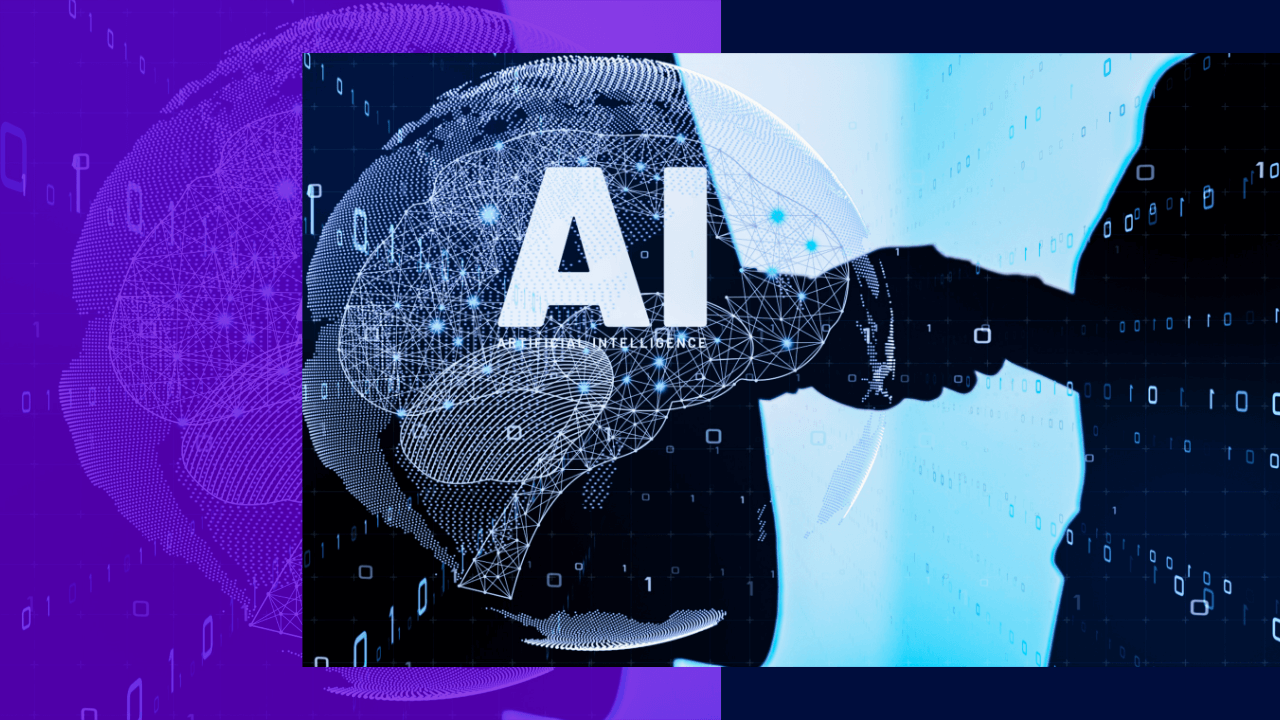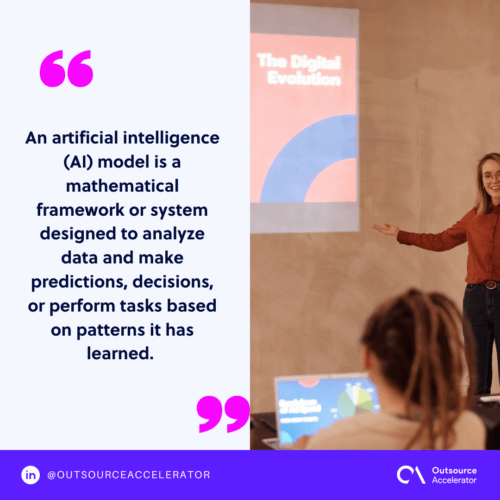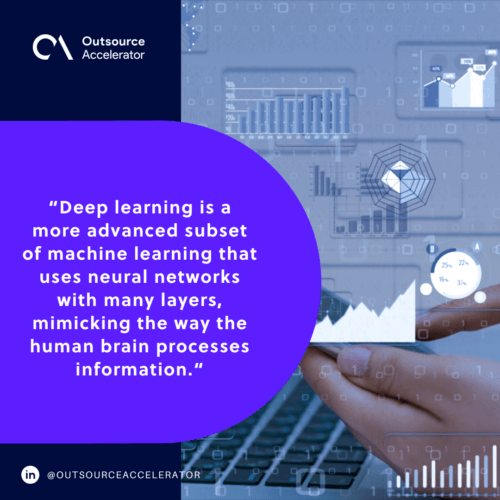10 Examples of AI models: How to fully leverage these innovations

List of common AI models
- Linear Regression
- Logistic Regression
- Decision Tree
- Convolutional Neural Netwroks (CNNs)
- Recurrent Neural Networks (RNNs)
- Long Short-Term Memory Networks (LSTMs)
- Q-Learning
- Deep Q Networks (DQN)
- Policy Gradient Methods
- Generative AI
Artificial intelligence (AI) has transitioned from a futuristic concept to a fundamental component of contemporary business operations.
A recent survey by Canva and Harris Poll reveals that 84% of Chief Information Officers (CIOs) feel overwhelmed by the plethora of AI tools available. This highlights the rapid integration of AI into various business functions.
The growing surge in AI adoption has led businesses to invest in advanced AI models to enhance efficiency, decision-making, and innovation.
In this article, we will explore ten leading AI models and discuss how growing companies can fully leverage them to drive success.
What is an AI model?
An artificial intelligence (AI) model is a mathematical framework or system designed to analyze data and make predictions, decisions, or perform tasks based on patterns it has learned.
AI models are trained on vast datasets, allowing them to understand relationships within the data and apply that understanding to new, unseen situations.

These tech advancements are at the core of machine learning and artificial intelligence systems. They enable a wide range of applications across various industries, from healthcare to finance.
Here’s how AI models work:
- Data collection. The model is trained using large datasets, which can include images, text, or numerical data, depending on the type of AI model.
- Training. During the training process, the AI model processes the data to identify patterns and relationships. The model uses algorithms to improve its predictions over time based on the data it receives.
- Feature extraction. The model identifies key features or variables in the data that are most relevant for making predictions.
- Testing and validation. Once the model has been trained, it is tested on new data to assess its accuracy and generalization capabilities.
- Deployment. After validation, the AI model is deployed in real-world applications, where it can make decisions, automate tasks, or provide insights based on fresh data.
- Continuous improvement. These models continue to learn and adapt by incorporating new data, further refining their ability to predict or analyze situations accurately.
Artificial intelligence models are crucial in transforming business operations and decision-making, driving automation, personalization, and efficiency across sectors.
How programmers train AI models
Training an AI model is a complex process that involves several crucial steps to create a system capable of performing specific tasks. Programmers must carefully guide the model through a structured workflow to ensure it can handle tasks efficiently and accurately:
1. Gather data
The first step is gathering a substantial amount of relevant data. The quality and quantity of data directly impact the accuracy and performance of AI models.
The more data the model has, the more sophisticated it can become in recognizing patterns, making decisions, and handling complex algorithms.
2. Clean the data
Data cleaning is a critical step to remove inaccuracies, inconsistencies, or irrelevant data that could mislead the AI. In supervised learning, data cleaning helps teach the model how to produce the correct outputs.
For unsupervised learning, cleaning helps the AI model spot patterns and trends. Noise, or irrelevant data, is also eliminated during this phase.
It’s also important to regularly update the dataset to avoid making decisions based on outdated information.
3. Choose a model
Choosing the right model depends on the desired output and the type of AI (supervised, unsupervised, or reinforced learning). Programmers also consider available resources such as processing power and the scope of tasks the model should perform.
The selected model’s design must align with the problem the AI is solving.
4. Train the model
Training the AI model involves providing it with a training set of data, allowing it to learn from examples.
A validation set is then used to compare the AI’s predictions against the correct answers. This helps to determine how well the model is performing.
5. Test the model
After training, the model is tested to measure its performance. Success is evaluated based on precision (the consistency of results) and accuracy (how closely the model’s output matches real-world outcomes).
Testing helps identify any discrepancies that need to be addressed.
6. Deploy the model
Once testing is complete, the model is deployed into real-world applications. Programmers integrate the model into existing systems and ensure it has sufficient resources to perform efficiently.
7. Fine-tune the algorithms
As the AI model begins functioning, it’s important to continually fine-tune the algorithms. If the model produces inaccurate or biased results, adjustments are made.
This process of continuous learning and optimization allows the model to improve its predictions over time, ensuring it evolves and adapts as needed.
4 Types of AI models
There are several types of AI models, each with its own unique approach to handling data and making decisions:
1. Machine learning
Machine learning is a subset of AI where algorithms learn from data to make decisions without explicit programming.
In machine learning, the model is trained on a large dataset, allowing it to identify patterns and make predictions based on new, unseen data. The more data the model processes, the more accurate its predictions become.
2. Supervised learning
Supervised learning is a type of machine learning where the model is trained on a labeled dataset. Each input in the dataset has a corresponding correct output, and the model learns to map inputs to the correct output.
It is primarily used for classification and regression tasks, such as spam detection or predicting house prices.
3. Unsupervised learning
Unlike supervised learning, unsupervised learning works with unlabeled data. The model identifies patterns and structures in the data on its own.
It is commonly used for clustering tasks, such as grouping customers based on purchasing behavior or detecting anomalies in network traffic.
4. Deep learning
Deep learning is a more advanced subset of machine learning that uses neural networks with many layers, mimicking the way the human brain processes information.
These models excel at complex tasks like image recognition, natural language processing, and speech recognition.
Deep learning models require large datasets and significant computing power to train effectively.

10 Examples of AI models
Here are ten examples of AI models that showcase the diversity of approaches in artificial intelligence.
1. Linear Regression
Linear regression is one of the simplest AI models used to predict a continuous outcome based on one or more input features. It works by fitting a straight line to data points, minimizing the difference between predicted and actual values.
It’s commonly used in areas like finance for predicting stock prices or in real estate for estimating property values.
2. Logistic Regression
While similar to linear regression, logistic regression is used for binary classification tasks, where the outcome is one of two possible values.
It uses a logistic function to model the probability that an instance belongs to a particular class. This AI model is often applied in spam detection, medical diagnosis, and customer churn prediction.
3. Decision Trees
Decision trees are used for both classification and regression tasks. They work by splitting data into subsets based on feature values, creating a tree-like structure of decisions. Each branch represents a decision rule, and the leaves represent the outcome.
Decision trees are intuitive and easy to interpret, often used in applications like credit scoring and customer segmentation.
4. Convolutional Neural Networks (CNNs)
Convolutional Neural Networks are a type of deep learning model commonly used in image processing.
These networks consist of layers that automatically learn spatial hierarchies of features, making them ideal for tasks like image classification, object detection, and facial recognition.
CNNs are widely used in healthcare for analyzing medical images, and in autonomous vehicles for object recognition.
5. Recurrent Neural Networks (RNNs)
Recurrent Neural Networks are designed to handle sequential data, where the output depends on previous inputs.
This makes them particularly useful for tasks involving time-series data or sequences, such as speech recognition, language modeling, and financial forecasting.
RNNs have applications in voice assistants and predictive text systems.
6. Long Short-Term Memory Networks (LSTMs)
Long Short-Term Memory Networks are a type of RNN that is better at handling long-term dependencies in data. They are particularly useful for tasks where long-term memory is important, such as speech synthesis, text generation, and machine translation.
LSTMs overcome the vanishing gradient problem that traditional RNNs face, allowing them to remember information over longer periods.
7. Q-Learning
Q-learning is a reinforcement learning model that helps agents make decisions by learning from their environment through trial and error.
It uses a Q-table to evaluate actions and rewards, aiming to maximize cumulative reward over time. Q-learning is applied in areas like robotics and game AI, where agents learn to navigate complex environments.
8. Deep Q Networks (DQN)
Deep Q Networks combines Q-learning with deep learning techniques, using neural networks to approximate the Q-table. This allows it to handle more complex, high-dimensional environments.
DQNs have been used in video games, where they have successfully learned to play games like Atari games at a superhuman level.
9. Policy Gradient Methods
Policy gradient methods are another approach on reinforcement learning.
Unlike Q-learning, which focuses on evaluating actions, policy gradients directly learn a policy — a mapping from states to actions.
This method is often used in continuous action spaces and is commonly applied in robotics, natural language processing, and game playing.
10. Generative AI
Generative AI refers to models that can generate new content based on the patterns they learn from training data. Examples include generative adversarial networks (GANs) and variational autoencoders (VAEs).
These models are used for creating realistic images, music, and even text, with applications in art, design, and entertainment.
Deploying AI models
Utilizing AI models marks the transition from development to real-world application. Businesses that integrate these tech advancements into existing systems can:
- Unlock new efficiencies
- Improve decision-making
- Drive innovation
Successful deployment requires careful planning, resource allocation, and continuous monitoring to optimize performance and adapt to evolving needs. In most cases, working with a reputable provider such as Acquire Intelligence is the smartest choice for businesses. This paves the way for long-term growth and success.







 Independent
Independent




